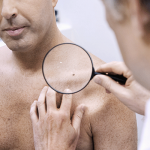Skin cancer is one of the most common cancers throughout the world. In America, roughly 1 in 5 people develop skin cancer in their lifetime and more than two people die of the disease every hour. Detecting and treating skin cancer early is both critical and effective, as early attention raises the five-year survival rate of melanoma to 99 percent.
Moles are commonly understood as indicators of potentially serious issues, but it is often difficult to interpret their significance. After all, moles are a prevalent feature, and the vast majority are benign, with only about 1 in 100 requiring attention. Knowing how to spot early signs of skin cancer and distinguish between normal moles and irregular moles is essential to begin a proactive conversation with your dermatologist.
Moles and signs of skin cancer
Skin types and complexions are unique to every individual, with different needs and susceptibilities to developing severe conditions.
Skin cancer, particularly melanoma, can be tricky. Melanoma manifests in different ways that are hard to identify. Talking with your doctor is vital if you find any irregularities. There are familiar warning signs of skin cancer to look for in moles, and the ABCDE method is an excellent place to start.
The ABCDE Method
- Asymmetry: Melanomas usually reveal themselves in the shape of a mole. If a mole is more asymmetrical in shape, it may be problematic.
- Border: The edges are not smooth and appear ragged, coarse or uneven in many cancerous moles.
- Color: Moles that are not a flat color and appear to combine different shades of brown, tan or black can indicate issues. As they grow, you may see new red, white, gray or blue areas appear as well.
- Diameter: Cancerous moles are generally larger than typical moles. Though they may be small at the onset, look for moles that have grown to about ¼” in diameter or larger.
- Evolving: If you notice a change in size, color, shape or texture in any pre-existing mole, it should be checked.
Other indicators
A normal, healthy mole will be a flat color, usually oval or circular shaped, with a well-defined edge and smaller than ¼” in diameter. Following the ABCDE method is an excellent way to identify abnormal moles, but there are other early indications of trouble in how moles present themselves.
If you find an odd mole — sometimes called the “ugly duckling” — among a cluster of similar moles that is larger, lighter or darker, or otherwise different, it can be a vital warning sign of skin cancer.
Moles, as mentioned, can be easy to misidentify as malignant, so the most crucial consideration is change. Check for changes in color, shape, size, elevation or new growths that you never noticed before. Itching, bleeding, crusting or discharge from moles are other clear indicators of an issue.
Skin cancer risk factors
Apart from moles and beauty marks, most features of your skin, such as cherry angiomas, will not develop into cancer. In fact, most moles are going to be non-cancerous. However, certain skin types and lifestyle factors can place you at higher risk.
Atypical mole syndrome and a history of melanoma in your immediate family place you at a high potential for developing melanoma yourself. Atypical mole syndrome occurs when you have a high number of large and irregular moles. In general, individuals with 50 or more moles have a higher risk of developing melanoma.
UV radiation exposure is believed to be the leading cause of melanoma. Regular use of tanning beds and sunlight exposure can increase the risk of developing skin cancer for anyone. Because your skin’s pigment acts as a protective element, those with fair skin and a history of sunburns are at higher risk. Avoiding the sun when you can, using appropriate sunblock and avoiding tanning beds are critical steps in reducing your chances of developing melanoma.
Check yourself for early signs of skin cancer
Nearly everybody has moles somewhere on their body and very few should be cause for concern. Even those rare spots that could develop into problems can be easily resolved with early intervention. The critical concern is checking your body regularly for any changes. Having an acute awareness of your skin’s unique features will allow you to identify any changes that may be worth looking into.
Schedule a yearly skin exam
The ways melanoma can develop are as unique as our skin, and the surest path to prolonged health is an annual skin checkup with your dermatologist. Melanoma can hide in hard-to-exam areas, like under fingernails and sometimes may be invisible to the naked eye, blending in with your natural skin tone. Regular checkups can help you respond to these issues before they transform into more serious conditions. Perform monthly self-exams between doctor visits to note any changes and make special follow-ups if you are concerned with your skin’s look, feel or sensitivity.
Columbia Skin Clinic’s board-certified dermatologists are trained to screen, diagnose and treat all skin disorders, including skin cancer. With four convenient locations, it has never been easier to visit the dermatologist, and it just might save your life.






